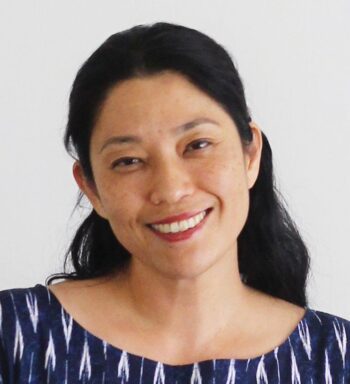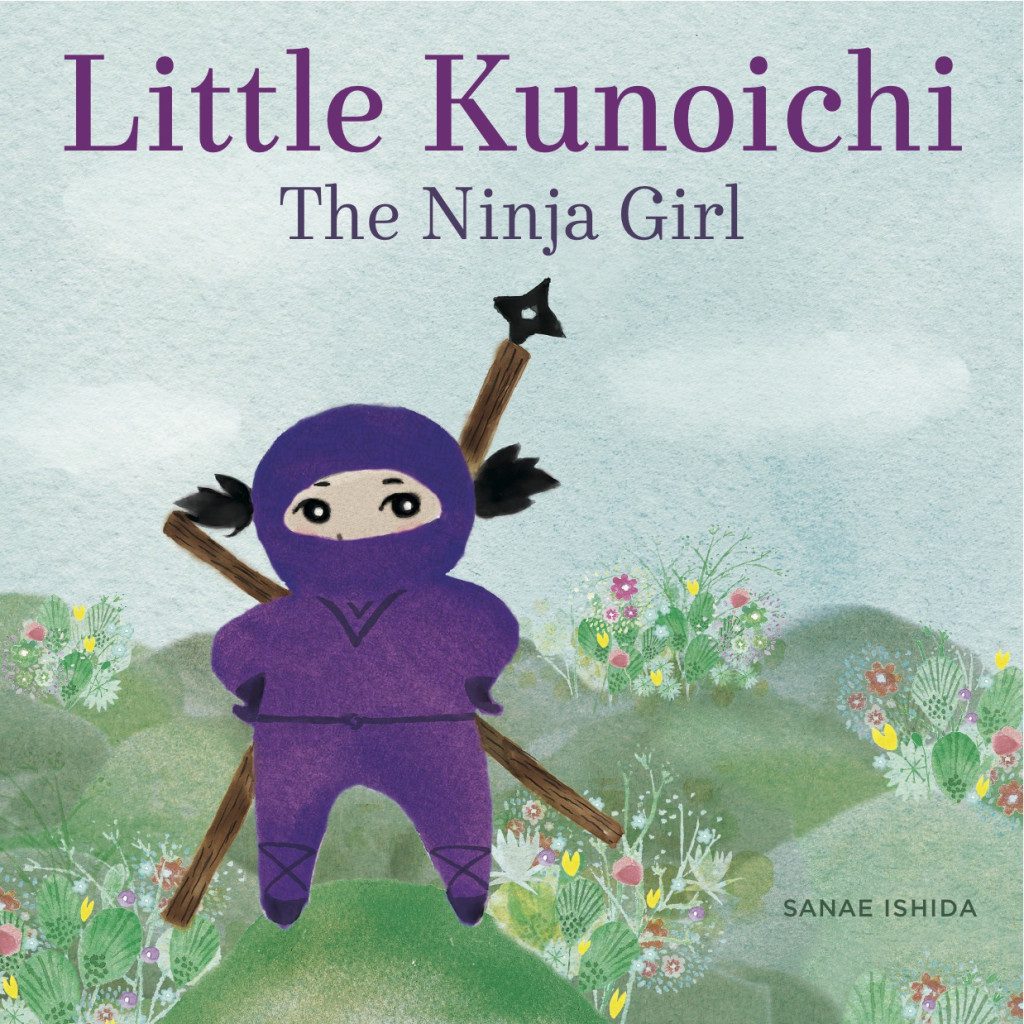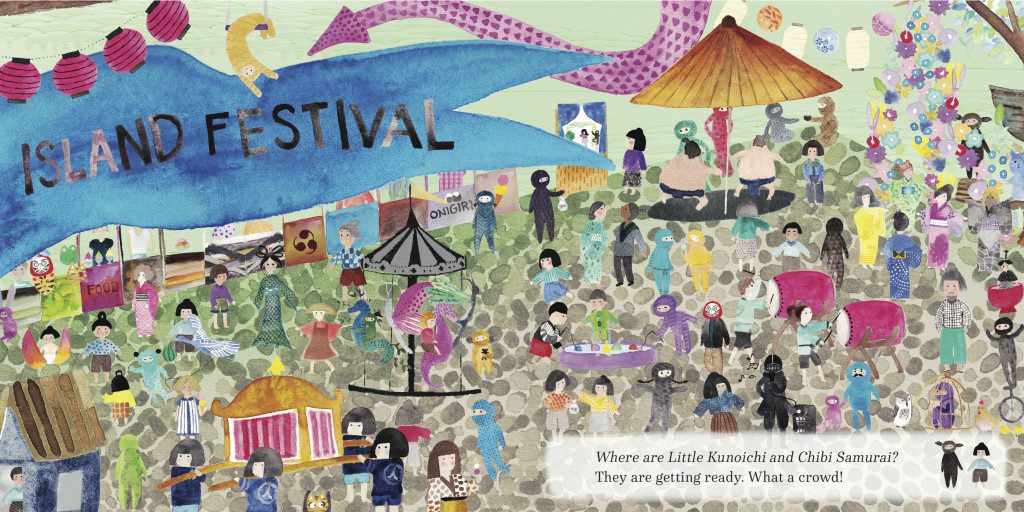
Sanae Ishida spent years attempting to ignore her creative calling, and trying her best to work in a suit and an office. Ultimately, fending off a need for creative outlet and toiling in a corporate life that didn’t suit her and was destructive to her health and psyche. Now, Sanae has no problem laughing when she describes herself as a “very unsuccessful businesswoman.” Happily artistic these days, Sanae caught up with us over coffee on a sunny Seattle day to discuss her debut children’s book, Little Kunoichi, The Ninja Girl, and her creative process.
Little Kunoichi, The Ninja Girl, combines elements of Sanae’s own Japanese heritage and upbringing with a feisty young ninja protagonist. Both the author and illustrator, Sanae weaves the story of her girl-ninja together with watercolor drawings.
Little Kunoichi and Sanae’s second book, coming in spring 2016, are published by Sasquatch Books of Seattle.
***
The Rumpus: What was your inspiration and how did you decide to write a children’s book, and particularly Little Kunoichi?
 Sanae Ishida: I always, always wanted to write and illustrate a children’s book, ever since I was a teeny tiny kid. I did a presentation at my daughter’s school for Little Kunoichi and I was looking around the room—it was second and third graders—I thought, you know what, I have wanted to do this since before I was their age. I remember being in elementary school looking at picture books and thinking, “I want to do this.”
Sanae Ishida: I always, always wanted to write and illustrate a children’s book, ever since I was a teeny tiny kid. I did a presentation at my daughter’s school for Little Kunoichi and I was looking around the room—it was second and third graders—I thought, you know what, I have wanted to do this since before I was their age. I remember being in elementary school looking at picture books and thinking, “I want to do this.”
But you know, life happens, and I went corporate for many, many years, and I just don’t know. I grew up in an artistic family and there was this weird reverse thing where my mom expected me to be an artist and I rebelled against that, and I said I wanted to be a business person—as it turns out, I am a horrible business person. For so long I resisted anything creative or artistic. I was doing an ironic opposite of what most people do (being artistic with non-artistic parents).
But I noticed that at every job I took I would always somehow end up doing illustrations or graphic design, or something creatively similar, even though it wasn’t part of my job at all. I had a very bad experience with one corporate job, and that sort of led me down the rabbit hole of thinking that obviously something was not working with all of these things I had been trying to do. My health was in ruins. I needed a change. That led to my illustrations and I really love sewing, so I picked that up again. I was producing a lot of things and really loving it and felt happy. And my daughter would say, “You seem so happy!” I felt like things were happening serendipitously.
Rumpus: How was the process of putting the book together?
Ishida: I always knew I had wanted to write a book about a girl. In my early twenties I had tried to create a book about a little girl who went on an adventure. It was a total bomb—even I didn’t like it. I had this idea and it wasn’t gelling.
But once I decided I wanted to do it about a ninja girl, specifically, it was like one of those movie reels. I could just see the whole story in my brain.
So I sat down and, like I said it was already all there, and made a storyboard. Very little has changed from the little storyboard I created to the real book. I think that’s very fascinating. Now that I’ve had a second book in progress I realize that is not always the case. I feel like I was supposed to do the story of the ninja girl, and it was created organically like that.
The title came about because down on Stone Way here in Seattle there used to be a coffee shop called Tiny Ninja, and one day as I was walking in front of the café in the midst of story ideas, I saw that they had a T-shirt with a little ninja, and the Japanese female word for ninja, “kunoichi,” popped into my brain. And it fit!
Rumpus: The sense of place in the story is so strong, how did you decide on it and did you have a feeling of a specific place or influence when you were creating it?
Ishida: It’s definitely influenced a lot by Japanese comic books. I grew up reading those.
I love all of the book obviously, but the festival page in particular because I included a lot of references from my childhood. The Japanese folk tales I grew up hearing, like the peach boy, and the underwater princess, and the Japanese dancing, are all part of this page, and there are classic Japanese games that you play at festivals that are there too. I grew up watching a lot of puppet shows, and karaoke is huge part of Japanese cultural. Even though it is an imaginary island, my Japanese culture is such a huge part of the story.
Rumpus: I appreciate how you incorporated your heritage. I grew up on an island, and my father was a land surveyor, so I am a sucker for authentic island stories. And maps!
Ishida: I totally understand. I love maps too so I knew I had to have a map with a legend. I also love having factoids with books. As a parent myself, who reads books over and over, I think it’s cool to have more information for parents to explain to their kids.
Rumpus: Children’s books are also a great way for parents to teach their kids. The message in Little Kunoichi is very present. Can you talk about that, and why it is important?
Ishida: I wanted the feel of the book to be about perseverance and hard work and friendship and teamwork, and also about not being perfect. I feel like there’s too much perfection sold in the world—on Pinterest and social media—and it all promotes this really unattainable sense of perfection. I have this wonderful little girl who I think deserves to understand that perfection is not important.
She is a huge inspiration for me. When she was about five or six, we went to an ice skating rink. I remember she had never ice-skated before, and she kept falling. She would get up and she would fall and she would get up and she would fall, and she was so gritty. And I, being the over-protective parent, would keep trying to help her and she kept saying “NO” and she was gripping onto the side railing and pulling herself up and falling again. It was terrifying but awesome. She skateboards now, and I see the same grit there too. She is badass. I don’t want her to ever forget that that is part of who she is. Because I am already seeing how things like peer pressure are affecting her. So that was a huge reason why I wanted to write a book about promoting the hard work and the never giving up.
Rumpus: At the end I think it says, “To get better, not to be perfect.”
Ishida: Unattainable perfection is boring. Perfection is boring.
Another cool thing happened when I’d been doing a lot of photo shoots for the second book, and my daughter had seen them. One day we were looking at something, a J. Crew catalog I think, and we came across a pretty outfit and she says, “I bet you that there are huge messes right around the edges of that photo while they are taking it.” I still think about how cool that moment was, and how she was aware that everything was set up to produce a pretty picture, and that there were things that weren’t being shown. We talked about how you can be inspired by it’s beauty but also be aware of what isn’t real about the picture. I was quite proud.
Rumpus: Going back to how the story came to you all at once, did you start writing first or drawing first?
Ishida: It was definitely visually driven at first. I usually need the image first and then I write.
Rumpus: What is your medium?
Ishida: It’s all watercolor wash. I individually hand-paint each element and then collage it together in Photoshop. I can move things around and change colors. Part of my presentation that I show the kids is each individual drawing and how it goes into the whole picture.
Rumpus: Did your daughter have much input on the story or images?
Ishida: Oh she had a lot. I showed it to her many, many times and she’d say things like “Oh, I don’t know about that. Mom, you need more action. The dragon needs to be pink.” She was adamant about the pink dragon, which I think was brilliant.
Rumpus: You’ve been drawing a long time it sounds like. Did you draw as a child?
Ishida: Definitely. My mom is an artist. From the moment we were able to hold a pencil, she was teaching us. And just through example really. I can’t remember if she ever taught us specifically, but she was always painting herself, which we picked up on as her kids.
Both my brothers are also artists. They are comic book artists. I took an art class in high school, but then in college and beyond I didn’t do anything for a really long time. You remember, back when I was trying to be a businesswoman. A very unsuccessful businesswoman!
I am a firm believer that you can start art at any age. I didn’t pick up watercolor until I had my daughter. I think it was the surge in hormones. I suddenly had this huge need to make things, anything! I needed to cook and draw and paint and all these things.
Writing is definitely a different part of the brain than drawing or working with your hands. I worked for Pottery Barn for awhile as a production assistant, which just meant that I created the set layouts for all of the photo shoots. It’s really repetitive work. It is very precise. Most people think it is super boring, and I just loved it. I loved getting the accuracy down to the right percentage. It was so satisfying to me. I remember talking to one of the designers there who worked in a more free-flowing method, and he couldn’t understand how I could do it, he thought there was no creativity in it. I don’t know, though, there is something about using a different part of my brain that works for me.
Rumpus: What are your other artistic endeavors?
Ishida: Sewing. And I love photography. I am not very good at it yet but I’m working on it. I want one day to do ceramics. I love ceramics. I did a little bit when I lived in Japan.
I think everyone should be making things. I am really good with routine and habits. I love structure. I love variety within structure. I like to have a really good framework and then go nuts inside of it. Those traits help me create.
Rumpus: Would you like to do other stories in this children’s book world you created?
Ishida: I would love to! Who knows. I have so many other children’s books ideas. Many were rejected. Since my daughter is half, I want to do a kids book about biracialism. I know there are books out there, but I feel like I cant find very many.
Rumpus: Do you ever do stories just for your daughter that you aren’t going to publish?
Ishida: Oh I have! I used to make up stories for her all the time. I did make a little alphabet picture book that included her and her friends. They went on an adventure and interacted with all the letters. It was teeny tiny and they loved it. She’s a big reader herself—now she is really into chapter books.
Rumpus: What do you hope that kids will really like about Little Kunoichi and what do you hope that adults will really like about the book?
Ishida: I hope they both get the message. I think for parents too, I know that I am guilty of wanting to be the perfect parent and get everything just right, but it’s okay to not be perfect. I think it’s applicable to everyone.





